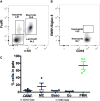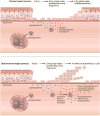Neutrophils are a major source of the epithelial barrier disrupting cytokine oncostatin M in patients with mucosal airways disease
- PMID: 27993536
- PMCID: PMC5529124
- DOI: 10.1016/j.jaci.2016.10.039
Neutrophils are a major source of the epithelial barrier disrupting cytokine oncostatin M in patients with mucosal airways disease
Abstract
Background: We have previously shown that oncostatin M (OSM) levels are increased in nasal polyps (NPs) of patients with chronic rhinosinusitis (CRS), as well as in bronchoalveolar lavage fluid, after segmental allergen challenge in allergic asthmatic patients. We also showed in vitro that physiologic levels of OSM impair barrier function in differentiated airway epithelium.
Objective: We sought to determine which hematopoietic or resident cell type or types were the source of the OSM expressed in patients with mucosal airways disease.
Methods: Paraffin-embedded NP sections were stained with fluorescence-labeled specific antibodies against OSM, GM-CSF, and hematopoietic cell-specific markers. Live cells were isolated from NPs and matched blood samples for flow cytometric analysis. Neutrophils were isolated from whole blood and cultured with the known OSM inducers GM-CSF and follistatin-like 1, and OSM levels were measured in the supernatants. Bronchial biopsy sections from control subjects, patients with moderate asthma, and patients with severe asthma were stained for OSM and neutrophil elastase.
Results: OSM staining was observed in NPs, showed colocalization with neutrophil elastase (n = 10), and did not colocalize with markers for eosinophils, macrophages, T cells, or B cells (n = 3-5). Flow cytometric analysis of NPs (n = 9) showed that 5.1% ± 2% of CD45+ cells were OSM+, and of the OSM+ cells, 56% ± 7% were CD16+Siglec-8-, indicating neutrophil lineage. Only 0.6 ± 0.4% of CD45+ events from matched blood samples (n = 5) were OSM+, suggesting that increased OSM levels in patients with CRS was locally stimulated and produced. A majority of OSM+ neutrophils expressed arginase 1 (72.5% ± 12%), suggesting an N2 phenotype. GM-CSF levels were increased in NPs compared with those in control tissue and were sufficient to induce OSM production (P < .001) in peripheral blood neutrophils in vitro. OSM+ neutrophils were also observed at increased levels in biopsy specimens from patients with severe asthma. Additionally, OSM protein levels were increased in induced sputum from asthmatic patients compared with that from control subjects (P < .05).
Conclusions: Neutrophils are a major source of OSM-producing cells in patients with CRS and severe asthma.
Keywords: Oncostatin M; atopic asthma; chronic rhinosinusitis; epithelial barrier; granulocyte-monocyte colony-stimulating factor; neutrophils.
Copyright © 2016 American Academy of Allergy, Asthma & Immunology. Published by Elsevier Inc. All rights reserved.
Figures







References
-
- Holgate ST, Lackie P, Wilson S, Roche W, Davies D. Bronchial epithelium as a key regulator of airway allergen sensitization and remodeling in asthma. American journal of respiratory and critical care medicine. 2000;162:S113–117. - PubMed
-
- Xiao C, et al. Defective epithelial barrier function in asthma. The Journal of allergy and clinical immunology. 2011;128:549–556. e541–512. - PubMed
-
- Dejima K, Randell SH, Stutts MJ, Senior BA, Boucher RC. Potential role of abnormal ion transport in the pathogenesis of chronic sinusitis. Archives of otolaryngology–head & neck surgery. 2006;132:1352–1362. - PubMed
-
- Bernstein JM, Gorfien J, Noble B, Yankaskas JR. Nasal polyposis: immunohistochemistry and bioelectrical findings (a hypothesis for the development of nasal polyps) The Journal of allergy and clinical immunology. 1997;99:165–175. - PubMed
MeSH terms
Substances
Grants and funding
LinkOut - more resources
Full Text Sources
Other Literature Sources
Medical
Research Materials
Miscellaneous

